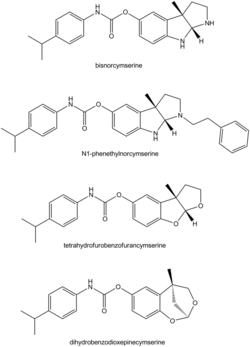Chemistry:Cymserine
 | |
| Identifiers | |
|---|---|
| |
| CAS Number | |
| PubChem CID | |
| ChemSpider | |
| UNII | |
| Chemical and physical data | |
| Formula | C23H29N3O2 |
| Molar mass | 379.504 g·mol−1 |
| 3D model (JSmol) | |
| |
| |
| (verify) | |
Cymserine is a drug related to physostigmine, which acts as a reversible cholinesterase inhibitor, with moderate selectivity (15×) for the plasma cholinesterase enzyme butyrylcholinesterase, and relatively weaker inhibition of the better-known acetylcholinesterase enzyme. This gives it a much more specific profile of effects that may be useful for treating Alzheimer's disease without producing side effects such as tremors, lacrimation, and salivation that are seen with the older nonselective cholinesterase inhibitors currently used for this application, such as donepezil. A number of cymserine derivatives have been developed with much greater selectivity for butyrylcholinesterase, and both cymserine and several of its analogues have been tested in animals, and found to increase brain acetylcholine levels and produce nootropic effects, as well as reducing levels of amyloid precursor protein and amyloid beta, which are commonly used biomarkers for the development of Alzheimer's disease (potentially indicating the drugs as candidates to be the first medicine capable of stopping, and even reversing, the progression of the disease).[1][2][3][4][5][6]
Unfortunately, the extremely promising results of cymserine administration in Alzheimer's patients is hindered by its toxic metabolites. A portion of administered cymserine is metabolized in the body into eseroline, a potent mu opioid agonist and neurotoxin.[7] As such, derivatives of cymserine which share its effects and mechanism of action but differ in their metabolic pathways would theoretically produce much fewer side-effects and have a greatly reduced risk of neurotoxic damage occurring with long-term administration (which could ultimately result in a greater loss of mental capacity than Alzheimer's itself). The search for cymserine derivatives which do not serve as prodrugs to eseroline is ongoing.
References
- ↑ "A new therapeutic target in Alzheimer's disease treatment: attention to butyrylcholinesterase". Current Medical Research and Opinion 17 (3): 159–65. 2001. doi:10.1185/0300799039117057. PMID 11900310.
- ↑ "Selective butyrylcholinesterase inhibition elevates brain acetylcholine, augments learning and lowers Alzheimer beta-amyloid peptide in rodent". Proceedings of the National Academy of Sciences of the United States of America 102 (47): 17213–8. November 2005. doi:10.1073/pnas.0508575102. PMID 16275899. Bibcode: 2005PNAS..10217213G.
- ↑ "Kinetic analysis of the inhibition of human butyrylcholinesterase with cymserine". Biochimica et Biophysica Acta (BBA) - General Subjects 1760 (2): 200–6. February 2006. doi:10.1016/j.bbagen.2005.10.003. PMID 16309845.
- ↑ "Kinetics of human serum butyrylcholinesterase and its inhibition by a novel experimental Alzheimer therapeutic, bisnorcymserine". Journal of Alzheimer's Disease 10 (1): 43–51. September 2006. doi:10.3233/jad-2006-10108. PMID 16988481.
- ↑ "Kinetics of human serum butyrylcholinesterase inhibition by a novel experimental Alzheimer therapeutic, dihydrobenzodioxepine cymserine". Neurochemical Research 33 (5): 745–53. May 2008. doi:10.1007/s11064-007-9490-y. PMID 17985237.
- ↑ "Tetrahydrofurobenzofuran cymserine, a potent butyrylcholinesterase inhibitor and experimental Alzheimer drug candidate, enzyme kinetic analysis". Journal of Neural Transmission 115 (6): 889–98. June 2008. doi:10.1007/s00702-008-0022-y. PMID 18235987.
- ↑ "Eseroline, a metabolite of physostigmine, induces neuronal cell death". Toxicology and Applied Pharmacology 106 (1): 28–37. October 1990. doi:10.1016/0041-008X(90)90102-Z. PMID 2251681. https://zenodo.org/record/1258264.
 |


